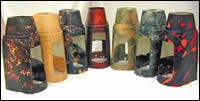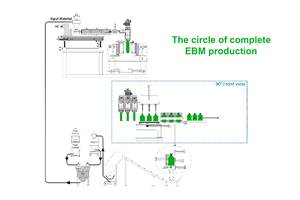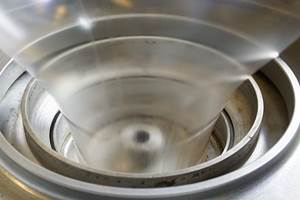Dye Sublimation Printing: Durable Color Decoration for 3D Parts
Dye sublimation, a dye-transfer process that got its start in the 1960s for use in textiles, has advanced in recent years to provide wear-resistant, full-color surface decoration of flat objects like mouse pads and tiles.
Dye sublimation, a dye-transfer process that got its start in the 1960s for use in textiles, has advanced in recent years to provide wear-resistant, full-color surface decoration of flat objects like mouse pads and tiles. Even more recently, it has proved applicable to three-dimensional products.
Developed by Kolorfusion International, Inc., the technology allows for transfer of a full spectrum of colors, shades, and designs to a variety of surfaces, including plastics, metals and glass. The company holds the process patents for the 3D decorating technology, which it uses for custom decorating and also licenses to others.
Applicable to any shape or size of part, the process requires no special tooling. It causes dyes to penetrate the surface of the polymer so that the impregnated images are highly resistant to wear. Kolorfusion can supply clear coatings for further protection. According to company president Steve Nagelle, the dyes and coatings have shown superb durability and uv resistance in commercial plastics products such as archery bows, gun stocks, all-terrain vehicle (ATV) components, bottle chillers, cooling canisters, snowboards, flashlights, and sunglasses clips.
The process is poised for wider application with the recent start-up in Shenzhen, China, of Kolorfusion's second decorating facility and with Kolorfusion's new marketing alliance with DuPont Engineering Polymers. DuPont's PBT, PET, acetal, and nylon resins are among those that are suited to the process. Such engineering resins provide new opportunities for the process in consumer electronics, power tools, appliances, sporting goods, and automotive components.
How it works
When the dyes are heated in this transfer process, they vaporize, and if they are in close proximity to a suitable substrate, such as a plastic or coating, the vapors penetrate the adjacent substrate by around 0.002 in. up to 0.25 in. The plastic substrate must be able to withstand temperatures of 280 to 375 F necessary to vaporize the dye.
Since the dyes are transparent, the substrate should be light in color—white, light gray, or beige. If the plastic substrate is translucent, it will remain translucent after coloring. "The lighter the substrate color, the better the result of this process," Nagelle says. He adds that the dyes will penetrate a black substrate but will not be visible.
When first used in textiles, this process allowed a printer to make a design on paper and then heat transfer it to knits or weaves. Explains Nagelle, "For flat-surface decoration such as snowboards, the design is first printed on paper, and then a hot press impregnates the paper design into the substrate."
For 3D decoration, Kolorfusion typically prints the design on an air-permeable and flexible textile-based medium called Kolortex. This is then placed around the object, which is put into a high-temperature film bag from which the air is pulled, forcing the textile to tighten around the substrate. The vacuum bag with the part is then placed in an oven for 5 to 40 min.
"We can now make digital designs and transfer them onto the part. If a user provides us with a design, we can scan the design digitally or receive it electronically and then use ink-jet technology to print the image onto Kolortex and transfer it onto the part," Nagelle notes.
He says the process was developed as an alternative to the dipping process developed by Cubic Printing of Japan and licensed to others for about 20 years. That method involves floating a preprinted film on a pool of liquid, allowing the film to dissolve and leaving a floating layer of inks into which the substrate is dipped. "This is a very expensive process and not as durable as dye sublimation, as it does not penetrate the part. Compared with the dip process, we are anywhere from 20% to 40% lower in cost," explains Nagelle.
The Kolorfusion process boasts several other advantages over the dip process. It does not require robotics, an artisan, or special training or fixturing. "Ours is a non-skilled, easy process whose cycle time depends on the substrate and size of the object. Typically our process can take from as little as 3 min up to 40 min. Its suitability will depend on how much capacity you need: You need more people for loading and unloading when you have large volumes and larger part areas to decorate. In general, the process is well suited to smaller volumes and to manufacturing in Asia where labor costs are lower."
Any shape or size
Initially, Kolorfusion aimed its process at outdoor applications such as archery and gun components and ATVs. With the DuPont alliance and the new China plant, Kolorfusion's aim is to use its process on plastic components from automotive to consumer electronics. Says Nagelle, "This could include a woodgrain look on side panels or on instrument panels or around gearshift consoles, where we would replace laminates. Consumer appliances, computer cases, or even cell phones, where film-insert molding and dip coating are used, are other areas that look promising because of the new China facility."
The largest plastic part decorated thus far is the 4 x 7 ft TPO cab on the Polaris Ranger ATV from Polaris Industries, Plymouth, Mich. Since early 2003, Kolorfusion has been printing "miles of Kolortex" for this application, says Nagelle. Polaris precoats the plastic part to reduce the gloss, applies the dye-sublimation process, and follows that with a clear topcoat for extra uv protection.
Daisy Air Rifle Co., Rogers, Arkansas, opted for dye sublimation to replace the dip process for a camouflage decoration on the stock and forearm of one of its lines of air rifles. Daisy had to change the plastic from the original ABS, which would not withstand the Kolorfusion process temperatures, to a modified nylon. While the material cost almost doubled, Daisy says the lower cost of decorating with dye sublimation completely offset the increase in material costs.
CaddyYo in Irvine, Calif., and PEK Systems in Windsor, Calif., have evaluated the Kolorfusion process to decorate bottle chillers and cooling canisters, respectively. Both companies are now aiming to produce these in China.
Archery equipment manufacturer Excalibur of Winnipeg, Manitoba, makes one of its crossbow models out of nylon, which is then decorated with dye sublimation. It also has a liquid polyurethane topcoat to provide a matte finish. This model uses a thermoset fiberglass composite for the "limbs," which are also decorated with the Kolorfusion process.
Related Content
DSM Launches an AI Powered Color & Mechanical Properties Prediction Tool
Called Lucidiris, this prediction tool can reduce time to market when developing colors of high-performance materials for a variety of applications.
Read MoreTosaf’s Investments in North America Result in 40% Increase in Production Capacity
Backed by a global presence, Tosaf provides localized additive and color solutions, and services for the plastic industry in North America.
Read MoreGet Color Changes Right In Extrusion Blow Molding
Follow these best practices to minimize loss of time, material and labor during color changes in molding containers from bottles to jerrycans. The authors explore what this means for each step of the process, from raw-material infeed to handling and reprocessing tails and trim.
Read MoreReduce Downtime and Scrap in the Blown Film Industry
The blown film sector now benefits from a tailored solution developed by Chem-Trend to preserve integrity of the bubble.
Read MoreRead Next
People 4.0 – How to Get Buy-In from Your Staff for Industry 4.0 Systems
Implementing a production monitoring system as the foundation of a ‘smart factory’ is about integrating people with new technology as much as it is about integrating machines and computers. Here are tips from a company that has gone through the process.
Read MoreUnderstanding Melting in Single-Screw Extruders
You can better visualize the melting process by “flipping” the observation point so that the barrel appears to be turning clockwise around a stationary screw.
Read More





















.png;maxWidth=300;quality=90)









